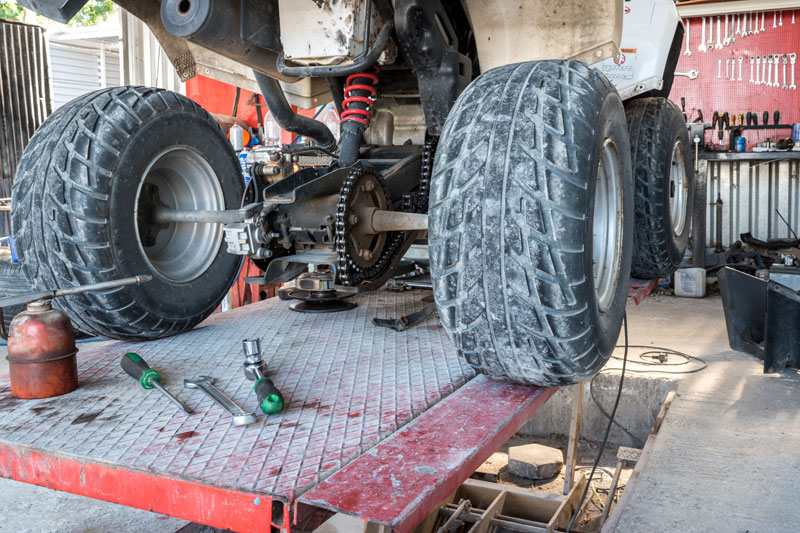Overcome the Wild: Your Ultimate ATV Exploration Waits For
Overcome the Wild: Your Ultimate ATV Exploration Waits For
Blog Article
ATV Riding Strategies: Grasping the Art of Off-Roading

Body Positioning
To successfully navigate through difficult off-road terrain, it is essential for ATV motorcyclists to consistently maintain correct body placing. Preserving the appropriate body setting while riding an ATV not only improves control and security yet also ensures the cyclist's safety. By adopting the correct body placing methods, motorcyclists can effectively disperse their weight, improve their equilibrium, and lessen the threat of injuries or accidents.
One key aspect of appropriate body placing is maintaining the feet on the foot secures. Placing the feet on the foot pegs permits the cyclist to keep stability and control over the ATV. The motorcyclist's knees should be somewhat bent, supplying a slight suspension to soak up shocks and preserve balance. Additionally, the cyclist's upper body ought to continue to be kicked back and versatile, enabling for fast and smooth activities when needed. This consists of maintaining a light hold on the handlebars to keep control without too much force.
Furthermore, the rider's eyes must constantly be focused in advance, checking the surface and anticipating any barriers or adjustments in the route. By maintaining an onward look, cyclists can make split-second decisions and react suitably to challenging surface.
Throttle Control
Structure upon the value of correct body placing for ATV riders, understanding throttle control is a crucial skill that allows cyclists to effectively navigate through different off-road terrains. Strangle control refers to the ability to manage the amount of power delivered to the ATV's engine. By recognizing how to manipulate the throttle, bikers can guarantee a smooth and controlled acceleration, permitting them to browse barriers with precision.
Unexpected or jerky motions can cause the ATV to shed traction or come to be unpredictable, making it tough to keep control. This strategy permits the ATV to maintain a steady rate and gives far better traction, minimizing the danger of accidents.
Along with smooth modulation, motorcyclists should likewise discover exactly how to stabilize the throttle with various other riding methods, such as body positioning and stopping. When climbing up steep hillsides, motorcyclists need to use adequate throttle to preserve momentum without causing or subduing the atv wheel spin. When descending high inclines, motorcyclists should make use of the throttle in combination with correct body stopping and placing to maintain control and stop the ATV from sliding or tipping over.

Braking Strategies
An essential aspect of ATV riding methods is grasping efficient braking strategies. Knowing how to brake effectively can make a considerable distinction in your security and control over the vehicle when it comes to off-roading. One of the most crucial stopping techniques is making use of the front brake greater than the rear brake. The front brake supplies most of the quiting power, so it is vital to utilize it sensibly. It is crucial to keep in mind that harsh braking with only the front brake can trigger the ATV to pitch ahead, potentially leading to loss of control or also flipping over. It is recommended to use both brakes concurrently, yet with more stress on the front brake. An additional important strategy is to prevent securing the wheels while braking. Locking the wheels can result in skidding, making it difficult to maintain control. To avoid this, squeeze the brake levers slowly and release them a little if you really feel the wheels securing. By understanding these stopping methods, you can improve your ATV riding skills and guarantee a secure and satisfying off-roading experience.
Cornering Strategies
One important facet of grasping ATV riding techniques is understanding efficient cornering methods. Collaring on an ATV can be tough, however with the ideal methods, riders can navigate turns securely and efficiently. The trick to successful cornering is to preserve control of the ATV while making the most of traction and reducing the risk of toppling.
To carry out a proper cornering method, riders should approach the turn at a proper speed, guaranteeing they are not going as well slow or as well fast. It is important to move the body weight towards the within the turn, leaning into it to keep balance and stability. This assists for the centrifugal pressure and maintains the ATV visit homepage upright.
Furthermore, cyclists need to keep their eyes concentrated on the exit point of the turn as opposed to the immediate course in advance (ATV). This allows for smoother and more accurate guiding, as it aids the cyclist prepare for any kind of barriers or adjustments in surface
Moreover, correct throttle control plays a considerable role in cornering. Bikers should regulate the throttle smoothly, staying clear of abrupt velocities or slowdowns, which can create loss of control.
Uphill and Downhill Riding
When navigating off-road surface, ATV riders need to understand the strategies for uphill and downhill riding to maintain control and make certain safety. Downhill riding, on the various other other hand, calls for riders to lean back and move their weight in the direction of the back of the ATV. By mastering the techniques for uphill and downhill riding, ATV riders can confidently take on numerous off-road surfaces and delight in a exciting and risk-free journey.
Conclusion
To conclude, grasping the art of ATV riding requires a combination of body positioning, throttle control, stopping techniques, and effective cornering. Uphill and downhill riding likewise need certain abilities to browse securely. By applying these strategies, riders can enhance their off-roading experience and improve their overall control and security on the ATV.
ATV Riding Techniques: Grasping the Art of Off-Roading is a thorough guide that digs right into the details of mastering the skills required for off-road ATV riding. Whether you are a novice or a seasoned cyclist, ATV Riding Techniques: Understanding the Art of Off-Roading offers important suggestions to aid elevate your off-road ATV riding skills to the following degree.

Report this page